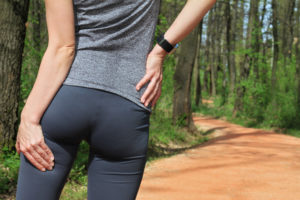
Degenerative disc disease may originate with an injury or it may occur over time as a matter of normal aging. When a disc wears down, tiny tears form in the outer ring of collagen fibers. The water content within the center area of the disc, the nucleus, declines, as well, exacerbating the tears with dryness. The domino effect of a dehydrated, mildly torn disc leads to bulging, bone spurs, misalignment of the vertebrae, and narrowed disc space which can lead to nerve impingement. Worn discs deplete spinal ability to perform normal functions, such as bending and twisting.
Signs of Degenerative Disc Disease
- Localized pain in an area of injury (even wear and tear is an injury).
- Intense, intermittent pain.
- Pain upon standing, sitting, bending, or twisting.
- Pain, tingling, or numbness in the legs.
- Pain improves when pressure on the spine is relieved, such as when lying down or standing in a pool.
Does Lumbar Degenerative Disc Disease Mean Surgery?
The big question about back pain is whether or not a person needs surgery. The answer is not always a hard yes. To determine the need for surgery or merit of non-surgical approaches, it is vital that a thorough consultation and examination occur. Pain and weakness are observed during a physical exam that also evaluates the movement of the spine. Imaging such as x-ray, CT, or MRI may also be performed to identify the severity of the disc injury. Only at this point can an accurate assessment be made.
In many cases of back pain associated with degenerative disc disease, non-surgical treatment is prescribed. This may include strengthening exercises and physical therapy, a period of rest and physical restriction before rehabilitation, injections of steroid medication to decrease inflammation, and prescribed medication to manage pain.
Innovation is a strong aspect of spinal surgery, and Dr. Albert is at the forefront of new techniques. To discuss the diagnosis and treatment of lumbar degenerative disc disease, schedule a consultation in our NYC office at 212-606-1004.


